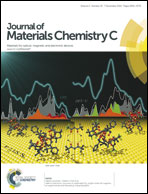Polycatenar unsymmetrical β-diketonate ligands as a useful tool to induce columnar mesomorphism on highly luminescent boron difluoride complexes†
Abstract
Three families of polycatenar 1,3-alkyloxyphenyl β-diketonate boron difluoride complexes with three (I) four (II) or five (III) peripheral chains unsymmetrically distributed, have been prepared and characterised. The thermal behaviour was analysed in light of their molecular characteristics, allowing us to establish that the complexes of III are liquid crystal materials in contrast to the absence of mesomorphism for the related derivatives I and II. Compounds III were found to be discotic liquid crystals exhibiting hexagonal columnar (Colh) mesophases. In addition, when the complexes presented a higher asymmetry degree related to the presence of flexible chains with different lengths at both substituents, the mesophases were raised at room temperature. The photophysical characterisation of the boron derivatives was also carried out, and in all cases it showed a high fluorescent emission in the green region for solution and for the solid state. All these features make these bifunctional luminescent mesogens good candidates to be potentially applied in technological fields, which require soft emissive compounds.


 Please wait while we load your content...
Please wait while we load your content...